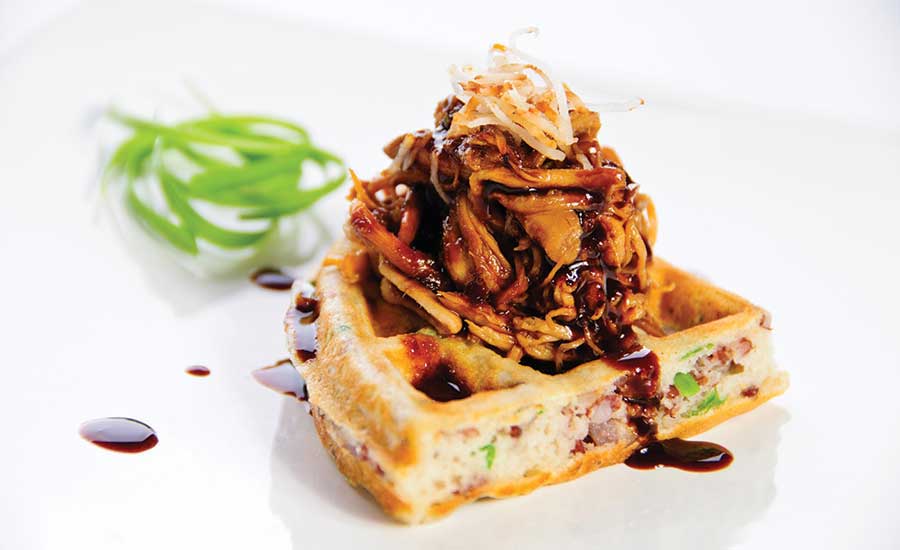As the whole and ancient grain wave continues to surge, chefs and product developers alike are pushing the envelope on the next evolution of breakfast, baked goods, appetizers and snacks. And as consumers continue to search for “better-for-you” ingredients, whole and ancient grains often rise to the top of the list.
We often look at grains as more of a neutral canvas that can provide the base for flavors. That said, each grain has its own unique flavor profile that should not be overlooked when choosing where to start.
Over the years, I have come to the conclusion that grains, more than almost any other ingredient, have quite subjective flavor notes when describing their subtle nuances, and the list of grains entering into the mainstream is quite extensive and rapidly growing.
Quinoa. Each color of quinoa (white, red and black) offers stark flavor differences, so we often do vertical tastings from white to red to black, not unlike a wine tasting. When working with quinoa, make sure to remove the natural bitter coating called saponin via a thorough rinse until the water runs clear. White quinoa has a soft texture and very mild, herbal flavor. Though “nutty” is a bit overused as a whole-grain descriptor, this clearly defines red quinoa in both flavor and texture. Black quinoa, on the other hand, makes the biggest leap in both flavor and texture. Its robust flavor comes from earthy overtones and mineral accents. Much more al dente than its counterparts, black quinoa is often blended to balance its heavier texture. All three are considered complete proteins and gluten free, elevating the marketing potential.
Sorghum. Grain sorghum for use in foods has entered the consumer food industry with a big splash. Though sorghum also boasts multiple colors, the white variety has been the dominant color to date. This gluten-free grain has an al dente texture with an almost pasta or wheat-like flavor profile—only sweeter.
Farro. Though available in whole-grain form, this ancient wheat is generally found in its quicker-cooking version of “semi-perlato.” This simply means it has had a bit of the bran layer etched off to allow quicker hydration, often called pearling or scarification. Still dominantly grown in and marketed out of Italy, this grain has the distinction of providing a slightly soft exterior while remaining al dente in its core. That, combined with its creamy flavor and buttery overtones, is quickly making it a consumer favorite.
Wild rice. The interesting thing about this grain (actually aquatic grass seeds) is that the flavor profile changes depending on the grade of rice used. Ranging from A+ grade to D grade, combined with where it was grown and how it was processed (parboiled or parched), we often use flavor descriptors like earthy and grassy to herbal and umami. More than most other grains, we find “nutty” often used, but usually including specific nut notes like “pecan,” “almond” or “hazelnut.”
Black rice. From China to Italy and the U.S., many varieties of black rice exist. Though the terroir and seeds may be different, the dominant characteristics tend to remain intact. The aroma of black rice is likened to that of freshly baked bread, slightly sweet and pleasant hints of yeast in the flavor profile. It tends to bleed out a natural indigo color when cooked. With puffed black rice, color bleeding is less of an issue.
For any grain, toasting (roasting), puffing (popping) and crisping can change the flavor profile from subtle to dramatic, but also the texture. Toasted grains stand up well to bold spices and acidic ingredients, as well as deep, earthy, umami flavors, without losing their identity.
The snack bar industry has embraced these further-processed grains with success, which has opened the door for trail mixes and clusters. Bakers have included ancient-grain flours with relative ease, but also intact grains—both as a topper or part of the dough mix. The cracker and chip category continues to expand with new products containing whole and ancient grains, paired with top-trending flavor profiles.
And let’s not forget about breakfast. Savory waffles and pancakes aren’t necessarily new to restaurant chefs, but we are seeing that ideation hit R&D kitchens, as well. Ancient Grain Adobo Chicken & Waffles anyone?




